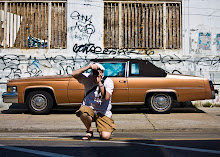Motivating this question is a sense of incredulity about the picture in question. Usually, I take it as a compliment, understanding it to mean, "Wow, I've never seen anything this beautiful or interesting myself. How lucky you were to be there with a camera to capture it." However, another way to take this question is that it is calling into question the authenticity of the photograph. Slyly, the questioner is suggesting that the picture isn't an accurate representation of the original subject. In this digital age where Photoshop and similar programs make it extremely easy to manipulate images (Iranian missiles anyone?), it's hard not to understand this suspicion.
A full discussion of the complications Photoshop adds to this issue will have to wait for another post to do it justice. For photography generally, though, the issue surrounding authenticity is intimately tied into the concept of what the original "really looked like" and that ultimately is a question of phenomenology, and as such, I can't answer it. I have no idea what *anything* looks like. I only know what my senses tell me about it. Hell, if you want to get really into it, you can ask whether we know with certainty that "it" is there at all outside of our perceptions of it. In this way, I have no way of knowing what it looks like in "reality," but only what it looked like to me at the time.
Let's look at a specific example. I took this photo last summer at Coney Island:


Now, as you can see, there's quite a difference between these two images. I didn't crop this image in the processing stage, but I did do some color correction which resulted as you can see in a much more vibrant photo.
Now, you could say, "Aha! This *isn't* what it really looked like. I *knew* it!" but such a supposition implies that the camera blindly and completely captures what was actually there to be captured. Instead, the technology itself in getting that original RAW image is working all kinds of voodoo on the subject, not the least of which is its transmuting the subject from three dimensions to two which results in various shifts in the visual geometry of the original subject.
Along with that, the sensor doesn't capture light and color in the same way the eye does. It can capture spectra of light that the human eye can't even see, for example, and so this original file is only an approximation of what the *camera* "sees," not the photographer. Therefore, that image straight from the camera doesn't resemble what I remember seeing nearly as much as the final, processed image does.
So I ask you, "Is that what it really looked like?" Depends on who you ask, me or the camera. For me, the artist, I can only say that the final, processed version is my best approximation of my memory of the subject on that day. It captures not only the physical actuality of the subject as closely as possible, but it also is my best attempt at capturing how that subject made me feel because ultimately that is what photography is all about. A photograph shouldn't just document the physical reality of the subject, but should attempt to communicate its emotional and subjective reality as well. That is my very long, and I'm sure, incomplete answer to a very short question. If you have any questions, comments, or feedback, I'd love to hear from you. Please comment below. Thanks and take care.
RAV
























